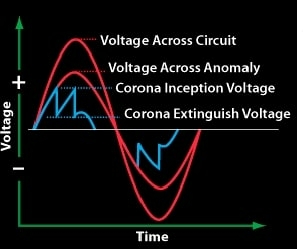source: EDN article
Steve Taranovich -April 26, 2016, Many designers treat transformers as if they were “garden variety” resistors in so many designs. They just select one that meets the circuit need for transforming electrical energy from one circuit to another without a direct electrical connection using mutual induction between two windings and having the necessary isolation voltage needed for the system design. But there is more to a transformer than that.
I met Kevin Bradley, Marketing Director, from Bicron Electronics Company, a Connecticut-based manufacturer of high-reliability, custom magnetics, at APEC this year. They announced an improvement in their line of VoltBoss™ corona-free transformers. Why is that important?
First of all, most engineers think of high voltage transmission lines when they hear the term corona. Have you heard of Corona bloom, a corrosive effect of partial discharge, is a leading cause of failure in magnetics components? Bicron’s new generation of VoltBoss™ transformers have been developed to eliminate corona failure (dielectric breakdown) for voltages up to 4.5kV in an amazingly small 1 sq. in. footprint.
This phenomena, frequently misunderstood by many designers as only applying to large, high voltage magnetics devices, is equally important in smaller magnetics devices in operating environments as low as 300V employed in equipment that must operate reliably over their lifetime – often decades.
Corona is caused by ionization of the media (usually air) surrounding an electrode /conductor. It is a function of the voltage and the surrounding relative humidity and air density. Corona is generated when a localized discharge resulting from the gaseous ionization in an insulation system when the voltage exceeds a critical value. That critical value was previously assumed to be about 1 kV but it can even be exhibited at levels down to 300V.
Corona inception voltage is the lowest voltage at which continuous corona of specified pulse amplitude occurs as the applied voltage is gradually increased. Corona inception voltage decreases as the frequency of the applied voltage increases. Corona can occur in applications as low as 300V.
Corona extinction or extinguish voltage is the highest voltage at which continuous corona of specified pulse amplitude no longer occurs as the applied voltage is gradually decreased from above the corona inception value. Thus, once corona starts, the voltage must be decreased to get it to stop.
Corona is not just a function of an Electric Field. It depends upon the surface and radius of curvature of the electrode/conductor. It is also dependent upon the rate of decay of the electric field away from the conductor/electrode. So the conductor with the smallest electric field at its surface is not the obvious solution.
The surface condition of the conductor is an important factor. Irregularities in the surface like dust, burrs, scratches and moisture are problems that will enhance the corona effect.
Bicron’s new transformer platform measuring just over 2 cu. in and weighing just 2.5 oz. achieves a partial discharge specification of an amazingly low level of <10 pC @ 4.5 kV.
The transformer’s manufacturing process, proprietary materials and designs assure best-in-class performance in minimizing partial discharge in mass-produced transformers, Kevin Bradley told me. This technology guards against field failures from poor designs, inferior materials as well as haphazard internal construction quality. Partial discharge is considered as a discharge that does not complete the path between the cathode and the anode of an insulation system. Bicron says that corona is a further progression of partial discharge as voltage levels increase to a high enough level to create a “Corona Bloom” which can be a serious threat to the operation of the magnetic device itself as well as the system it resides in.
Bradley told me that VoltBoss™ transformers have been in field use by major US and overseas OEM’s for thousands of cycles with no failures. With power ratings up to 200VA, input voltages up to 250V and partial discharge specifications as low as <5pC at on surprisingly small platforms, VoltBoss™ technology is available in board mounted units and larger toroid assemblies.
I got an eye-opening, new appreciation for the transformer after seeing what Bicron is doing with transformers and especially what they are doing to educate designers about these sometimes overlooked phenomena that can affect reliability and function in a system.































